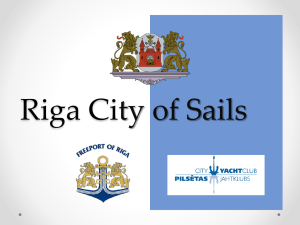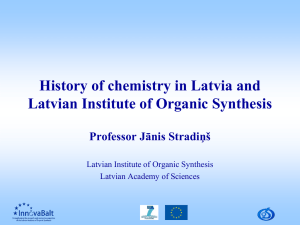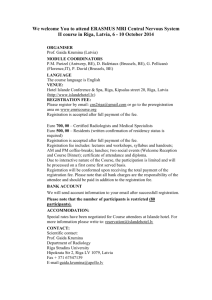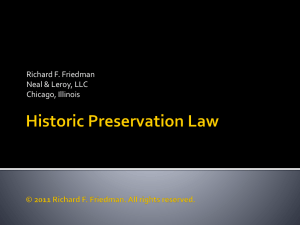Law On Preservation and Protection of the Historic Centre of Riga
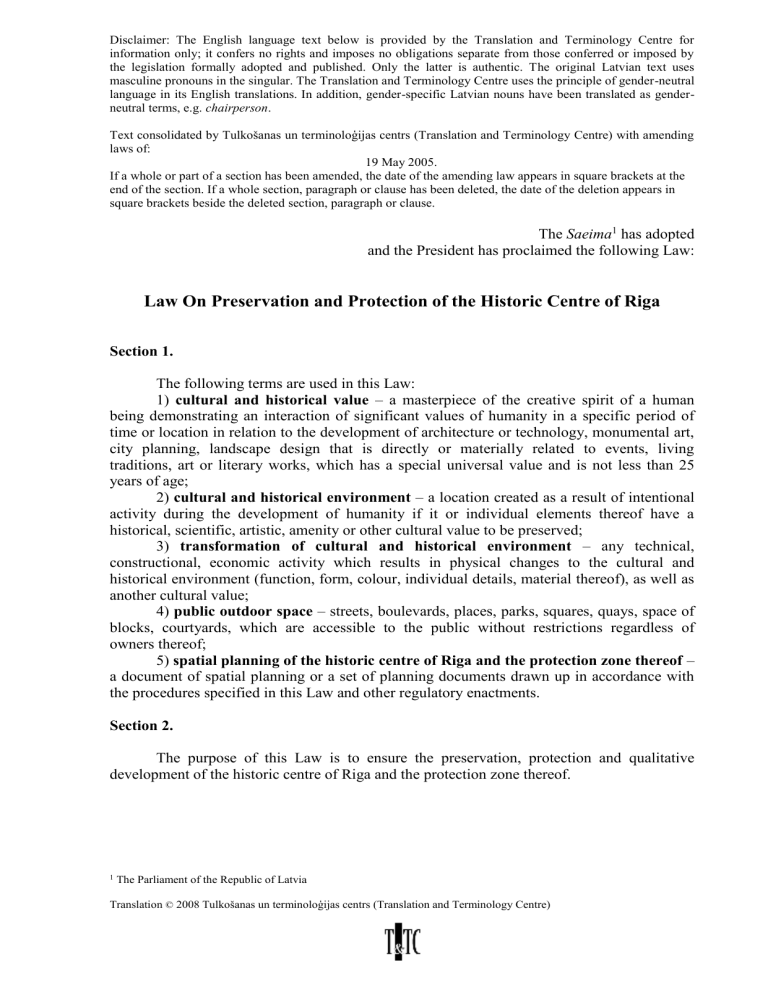
Disclaimer: The English language text below is provided by the Translation and Terminology Centre for information only; it confers no rights and imposes no obligations separate from those conferred or imposed by the legislation formally adopted and published. Only the latter is authentic. The original Latvian text uses masculine pronouns in the singular. The Translation and Terminology Centre uses the principle of gender-neutral language in its English translations. In addition, gender-specific Latvian nouns have been translated as genderneutral terms, e.g. chairperson .
Text consolidated by Tulkošanas un terminoloģijas centrs (Translation and Terminology Centre) with amending laws of:
19 May 2005.
If a whole or part of a section has been amended, the date of the amending law appears in square brackets at the end of the section. If a whole section, paragraph or clause has been deleted, the date of the deletion appears in square brackets beside the deleted section, paragraph or clause.
The Saeima 1 has adopted and the President has proclaimed the following Law:
Law On Preservation and Protection of the Historic Centre of Riga
Section 1.
The following terms are used in this Law:
1) cultural and historical value – a masterpiece of the creative spirit of a human being demonstrating an interaction of significant values of humanity in a specific period of time or location in relation to the development of architecture or technology, monumental art, city planning, landscape design that is directly or materially related to events, living traditions, art or literary works, which has a special universal value and is not less than 25 years of age;
2) cultural and historical environment – a location created as a result of intentional activity during the development of humanity if it or individual elements thereof have a historical, scientific, artistic, amenity or other cultural value to be preserved;
3) transformation of cultural and historical environment – any technical, constructional, economic activity which results in physical changes to the cultural and historical environment (function, form, colour, individual details, material thereof), as well as another cultural value;
4) public outdoor space – streets, boulevards, places, parks, squares, quays, space of blocks, courtyards, which are accessible to the public without restrictions regardless of owners thereof;
5) spatial planning of the historic centre of Riga and the protection zone thereof – a document of spatial planning or a set of planning documents drawn up in accordance with the procedures specified in this Law and other regulatory enactments.
Section 2.
The purpose of this Law is to ensure the preservation, protection and qualitative development of the historic centre of Riga and the protection zone thereof.
1 The Parliament of the Republic of Latvia
Translation © 2008 Tulkošanas un terminoloģijas centrs (Translation and Terminology Centre)
Section 3.
The task of this Law is to prescribe the status of the historic centre of Riga and the protection zone thereof, the territory thereof, the procedures for the preservation, protection, utilisation, as well as implementation of development projects and the requirements for the development of spatial planning of the historic centre of Riga and the protection zone thereof.
Section 4.
(1) The territory of the historic centre of Riga, the area of which is 438,3 hectares, and the territory of the protection zone of the historic centre of Riga, the area of which is 1574,2 hectares, is a part of the territory of the City of Riga. Boundaries of both referred to territories are specified in accordance with the boundary plan provided for in Annex 1 of this Law and the description of boundaries provided for in Annex 2 of this Law.
(2) The historic centre of Riga is a part of a cultural monument of State significance. The historic centre of Riga is included in the World Heritage List of the United Nations
Educational, Scientific and Cultural Organisation. Preservation and protection of the historic centre of Riga and the protection zone thereof shall be regulated by this Law, the Law On
Protection of Cultural Monuments, the United Nations Educational, Scientific and Cultural
Organisation’s Convention (1972) Concerning the Protection of the World Cultural and
Natural Heritage and other regulatory enactments.
Section 5.
(1) Any activity which may cause destruction or damage of cultural and historical values to be preserved and protected and located in the historic centre of Riga and the protection zone thereof, is prohibited therein.
(2) The following authentic cultural and historical values existing in the historic centre of
Riga and the protection zone thereof shall be preserved and protected:
1) the structure of the historic planning (with high quality transformations performed in subsequent years);
2) the panorama and skyline, perspectives of the vistas;
3) the historical build up (particularly – groups of constructions of the Middle Ages, art nouveau and wood), the scale and character thereof;
4) the archaeological cultural layer;
5) the public outdoor space;
6) the system of greenery and green zones;
7) the historical watercourses and water reservoirs;
8) the historical land surfacing (pavements, gravel paths, etc.); and
9) the historical elements of amenities.
(3) Transformation of the cultural and historical values to be preserved in the historic centre of Riga and the protection zone thereof shall be admissible if performance of the necessary transformation is the only way to ensure the development of the city and if the transformation does not result in lowering of the cultural and historical value of the historic centre of Riga and the protection zone thereof.
(4) Conversion of such historical residential buildings or re-planning of storeys of such buildings, which results in the irreversible loss of an opportunity to utilise the respective building for habitation, shall not be admissible in the historic centre of Riga. This provision shall not apply to the first storeys, basements and semi-basements of historical residential buildings.
Translation © 2008 Tulkošanas un terminoloģijas centrs (Translation and Terminology Centre) 2
(5) Modern, high quality architectural and environmental design objects may be created, as well as monuments may be installed in the historic centre of Riga and the protection zone thereof, taking into account the following provisions: the location selected for the object does not contradict with the structure of city planning of the historic centre of Riga and the protection zone thereof; the character, scale, rhythm of the historical group of buildings, the traditional selection of materials and the atmosphere created by architecture is respected; the object blends with the historical environment.
Section 6.
The territory of the historic centre of Riga and the protection zone thereof, which concurrently is also the territory of the free port of Riga in accordance with the Free Port of
Riga Law, shall be built up or otherwise transformed in conformity with the provisions of this
Law.
Section 7.
The Cabinet shall issue regulations regarding preservation, protection, utilisation of the historic centre of Riga and the protection zone thereof, transformation of the cultural and historical environment, as well as the procedures for implementation of development projects in specifying the requirements corresponding to the value of the respective cultural and historical environment (hereinafter – Cabinet regulations regarding the preservation and protection of the historic centre of Riga).
Section 8.
(1) Present and planned (permitted) utilisation of the historic centre of Riga and the protection zone thereof demonstrated in writing and in graphical form, the restrictions of utilisation, the requirements for the preservation of cultural and historical environmental and historical values, as well as such city blocks or groups of blocks, which require the mandatory development of a detailed plan, shall be determined by the spatial plan of the historic centre of
Riga and the protection zone thereof (hereinafter – spatial plan of the historic centre of Riga).
(2) The requirements, the boundaries of territories and objects specified in the spatial plan of the historic centre of Riga shall be specified more precisely in the detailed plan of city blocks or groups of blocks.
(3) City blocks or groups of blocks which require the mandatory development of a detailed plan, shall be indicated by the State Inspection for Heritage Protection in developing a draft spatial plan of the historic centre of Riga.
Section 9.
(1) The Riga City Council shall develop and approve the spatial plan of the historic centre of
Riga in the form of binding regulations, taking into account this Law, the Spatial Planning
Law, Cabinet Regulation regarding the preservation and protection of the historic centre of
Riga, and other regulatory enactments, as well as the requirements of the State Inspection for
Heritage Protection, recommendations of the Latvian National Commission for the United
Nations Educational, Scientific and Cultural Organisation (hereinafter – the Latvian National
Commission).
(2) The draft spatial plan of the historic centre of Riga (draft detailed plan of a city block or a group of blocks) shall be co-ordinated with the State Inspection for Heritage Protection prior
Translation © 2008 Tulkošanas un terminoloģijas centrs (Translation and Terminology Centre) 3
to approval thereof at the Riga City Council and if the Inspection does not have any objections it shall be promoted for approval at the Riga City Council. Concurrently the draft spatial plan of the historic centre of Riga shall be sent for examination to the Council for
Preservation and Development of Riga Historical Centre.
(3) The State Inspection for Heritage Protection or any other interested person shall propose to the Minister for Regional Development and Local Government the suspension of the binding regulations of the Riga City Council, with which the spatial plan of the historic centre of Riga (detailed plan of a city block or a group of blocks) has been approved, if:
1) the requirements specified in the Law regarding the procedures for the development and co-ordination of the spatial plan of the historic centre of Riga (detailed plan of a city block or a group of blocks) have not been observed; or
2) the spatial plan of the historic centre of Riga (detailed plan of a block or a group of blocks) is in contradiction with the provisions of this Law, the Law On Protection of Cultural
Monuments, the Protection Zone Law or other regulatory enactments.
Section 10.
(1) In order to promote the co-operation of institutions and taking of decisions in issues related to the preservation, protection and development of the historic centre of Riga and the protection zone thereof, a Council for Preservation and Development of Riga Historical
Centre (hereinafter – Council) shall be established, the composition (upon the proposal of the
Minister for Culture) and by-laws of which shall be approved by the Cabinet.
(2) The Council shall be a public consultative authority consisting of ten members:
1) the head of the State Inspection for Heritage Protection;
2) an official of the State Inspection for Heritage Protection who is responsible for accounting and research of cultural monuments;
3) an archaeologist or an architect of the State Inspection for Heritage Protection;
4) the head of the institution of the Riga City Council responsible for the protection of cultural monuments;
5) an official of the responsible institution of the Riga City Council responsible for the development of the historic centre of Riga;
6) an official of the responsible institution of the Riga City Council responsible for the planning of the City of Riga;
7) a specialist invited by the Minister for Culture;
8) a representative of the Latvian National Commission;
9) a representative of the Latvian Association of Architects; and
10) a representative of the Ministry of Regional Development and Local Government.
(3) Composition of the Council shall be approved for a period of three years. Members of the
Council shall elect the Chairperson of the Council from among themselves for a period of three years.
(4) The technical and organisational activity of the Council shall be ensured by the State
Inspection for Heritage Protection.
Section 11.
The following shall be within the competence of the Council:
1) to promote the process of development and implementation of the spatial plan of the historic centre of Riga;
Translation © 2008 Tulkošanas un terminoloģijas centrs (Translation and Terminology Centre) 4
2) to provide an opinion to the State Inspection for Heritage Protection and the responsible institution of the Riga City Council regarding the draft spatial plan of the historic centre of Riga or draft amendments thereto prior to approval thereof at the Riga City Council;
3) to evaluate the intentions regarding the building of new objects, reconstruction or demolition of buildings and structures, as well as to evaluate the installation and restoration of monuments in the historic centre of Riga and the protection zone thereof and to provide opinions regarding the impact of the respective intention on the cultural and historical environment to the State Inspection for Heritage Protection and the institution of the Riga
City Council responsible for the protection of cultural monuments if any of the referred to institutions has requested it. In taking a decision regarding the respective issue, the opinion provided by the Council shall be taken into account;
4) to provide an opinion if the State Inspection for Heritage Protection and the institution of the Riga City Council responsible for the protection of cultural monuments, in examining an issue regarding the preservation, protection or development of the historic centre of Riga and the protection zone thereof, have different opinions and if any of the referred to institutions has requested it. In taking a decision regarding the respective issue, the opinion provided by the Council shall be taken into account;
5) to propose the respective institutions to perform a control on whether the resources, which State or local government institutions obtain by renting (leasing) cultural monuments belonging to State or local government and existing in the territory of the historic centre of
Riga, as well as other revenues are being used in accordance with the requirements of this
Law;
6) to provide an opinion regarding draft regulatory enactments regulating the preservation, protection and development of the historic centre of Riga and the protection zone thereof;
7) to recommend the city blocks and groups of blocks existing in the historic centre of
Riga and the protection zone thereof, for which a detailed plan should be developed; and
8) to propose the examination of other matters related to the preservation, protection and development of the historic centre of Riga and the protection zone thereof in the respective institutions, as well as participate in the examination of such matters and provide opinions thereof.
Section 12.
The Council is entitled to receive the information necessary for deciding on matters within the competence thereof from State and local government institutions and the author or submitter of the building intention free of charge.
Section 13.
The Council is entitled to receive the information regarding utilisation of resources, which State or local government institutions obtain by renting (leasing) cultural monuments belonging to State or local government existing in the territory of the historic centre of Riga, as well as regarding utilisation of other revenues provided for in this Law from State and local government institutions free of charge.
Section 14.
Construction of new buildings in the public outdoor space of the historic centre of
Riga shall be admissible only according to projects acquired in open architectural
Translation © 2008 Tulkošanas un terminoloģijas centrs (Translation and Terminology Centre) 5
competitions, public evaluation and examination thereof in the Council and co-ordination thereof with the State Inspection for Heritage Protection in accordance with the procedures specified in regulatory enactments.
Section 15.
Prior to co-ordination of draft sketches of construction the State Inspection for
Heritage Protection in co-operation with the Latvian National Commission shall inform the
World Heritage Committee regarding the intended significant transformations of the cultural and historical environment in the historic centre of Riga and the protection zone thereof, which may affect the cultural and historical value thereof. Information shall be provided to the
World Heritage Committee as soon as possible in order to ensure the preservation of the historic centre of Riga as the world cultural heritage.
Section 16.
Resources, which State or local government institutions obtain by renting (leasing) cultural monuments belonging to State or local government and existing in the territory of the historic centre of Riga, fines for damaging and destruction of such cultural monuments, as well as compensation of losses related to such cultural monuments shall be transferred to the revenues of the State or local government core budget.
[19 May 2005]
Section 17.
(1) A fund for Preservation and Development of the Historic Centre of Riga (hereinafter –
Fund) shall be established for promotion of the preservation and development of the historic centre of Riga, and financial resources thereof shall consist of:
1) donations and gifts of natural and legal persons (also natural and legal persons of foreign states and international organisations);
2) payments of fines for administrative violations in the field of protection of cultural and historical monuments, except fines referred to in Section 16 of this Law;
3) compensation of losses for transformation of the cultural and historical environment, except compensation of losses referred to in Section 16 of this Law; and
4) State and local government grants.
(2) The resources of the Fund shall be stored at the Treasury.
(3) The resources of the Fund shall be used for scientific, technical, educational and administrative measures in order to detect, research, protect, conserve and restore, as well as to popularise the historic values and the cultural and historical environment of the historic centre of Riga and to promote the creation of modern, high quality architectural and environmental design objects in the historic centre of Riga.
(4) The Cabinet shall determine the holder of the resources of the Fund, as well as prescribe the procedures for taking decisions regarding usage of the resources of the Fund and provision of information regarding used resources of the Fund.
[19 May 2005]
Translation © 2008 Tulkošanas un terminoloģijas centrs (Translation and Terminology Centre) 6
Transitional Provisions
1. By 31 December 2003 the Cabinet shall issue the regulations referred to in Section 7 of this
Law.
2. The Riga City Council shall perform the necessary measures so that the spatial plan of the historic centre of Riga would be developed, accepted and come into effect not later than 1
July 2004.
3. The Cabinet shall approve the composition of the Council and by-laws thereof within three months after the Law has come into force.
4. Provisions of Section 16 of this Law shall come into force on 1 January 2004.
5. Until the coming into effect of the spatial plan of the historic centre of Riga it is prohibited to construct new buildings in the public outdoor space of the historic centre of Riga (except in cases referred to in Clause 8 of these Transitional Provisions), demolish historic buildings
(except the buildings in a state of disrepair if they pose a threat to the health or life of people in the public outdoor space), reconstruct buildings and structures, as well as install and restore monuments if it significantly alters the cultural and historical environment.
6. Intentions regarding construction of new buildings, demolishing of historic buildings, reconstruction of buildings and structures, as well as installation and restoration of monuments (hereinafter in this Clause and Clause 7 of Transitional Provisions – construction intention) in the historic centre of Riga, to which the prohibitions referred to in Clause 5 of
Transitional Provisions do not apply, shall be examined at the Council until the time of coming into effect of the spatial plan of the historic centre of Riga. The Council is entitled to endorse a construction intention or to request that the necessary corrections are made and documents of the construction intention are re-submitted to the Council for examination, or to reject the construction intention. The Council shall examine the submitted proposals not less than once a month. The Council shall take a decision by a majority vote not later than within
30 days after submission of the documents of the construction intention. Decisions taken by the Council shall be available to the public. If the Council rejects the submitted construction intention, implementation of the project shall be suspended until the coming into effect of the spatial plan of the historic centre of Riga or a detailed plan of a city block or a group of blocks of the particular territory.
7. The Council decisions taken in accordance with the procedures specified in Clause 6 of these Transitional Provisions shall be sent to the Riga City Council, the State Inspection for
Heritage Protection and the author of the construction intention. Decisions may be contested to the Ministry of Culture or appealed to the court in accordance with the procedures specified by the Law.
8. Until the coming into effect of the spatial plan of the historic centre of Riga and in cases where a detailed plan of a city block or a group of blocks should be developed pursuant to the spatial plan of the historic centre of Riga – until coming into effect of the particular detailed plan, the Council shall approve a list of such places to be built up, which are significant from the point of view of urban construction, where construction of new objects in the public outdoor space shall be permissible only according to the projects obtained in open
Translation © 2008 Tulkošanas un terminoloģijas centrs (Translation and Terminology Centre) 7
architectural competitions, after public evaluation thereof, examination at the Council and coordination with the State Inspection for Heritage Protection.
9. Until the date of coming into effect of the spatial plan of the historic centre of Riga, the
Ministry of Culture shall be responsible for the material and financial provision necessary for performance of tasks delegated to the Council in Clauses 6, 7 and 8 of these Transitional
Provisions, as well as for legal and useful fulfilment of the tasks in supervising it.
10. Natural persons or legal persons may continue the construction works in the historic centre of Riga, which were legally commenced until coming into force of this Law.
11. Owners of the buildings existing in the historic centre of Riga who have commenced and performed conversion or re-planning of buildings until coming into force of this law, taking into account the procedures specified in regulatory enactments, shall, until 1 July 2004, arrange the documentation of buildings according to the type of use of the respective building indicated in documentation of the project.
The Saeima has adopted this Law on 29 May 2003.
President
V. Vīķe-Freiberga
Riga, 11 June 2003
Translation © 2008 Tulkošanas un terminoloģijas centrs (Translation and Terminology Centre) 8
Annex 1 to the
Law On Preservation and Protection of the
Historic Centre of Riga
Boundary Plan
___________ Boundaries of the historic centre of Riga
- - - - - - - - - Boundaries of the protection zone of the historic centre of Riga
Translation © 2008 Tulkošanas un terminoloģijas centrs (Translation and Terminology Centre) 9
Annex 2 to the
Law On Preservation and Protection of the
Historic Centre of Riga
Description of the Boundaries
Boundaries of the Historic Centre of Riga
The site of the world cultural heritage – THE HISTORIC CENTRE OF RIGA – shall include the territory, which is bounded by: Hanzas iela, E. Melngaiļa iela, K. Valdemāra iela,
Palīdzības iela, A. Briāna iela, Tallinas iela, A. Čaka iela, Matīsa iela, Avotu iela, Lāčplēša iela, E. Birznieka-Upīša iela, Elizabetes iela, Satekles iela, Marijas iela, Gogoļa iela,
Turgeņeva iela, Krasta iela, 11. novembra krastmala, Muitas iela, Citadeles iela, the green belt of the City Canal and the territory adjacent to Eksporta iela on the eastern side of Andrejosta.
Boundaries of the Protection Zone of the
Historic Centre of Riga
The protection zone of the site of the world cultural heritage – THE HISTORIC
CENTRE OF RIGA – shall include the territory, which is bounded by: Salu bridge, turn to
Mūkusalas iela, Bieķensalas iela, Jelgavas iela, continuation of the route of Jelgavas iela to
Raņķa dambis, Raņķa dambis, southern and western embankment of the Āgenskalna Bay, western embankment of Āzene, western embankment of Zunds, the median of Roņu pond and its extension thereof across the River Daugava to the middle of the Eksportosta mole, from there to the intersection of Eksporta iela and Lugažu iela, Lugažu iela, southern part of the railway branch line of the Port to the intersection with Ganību dambis, the railway branch line of the Port to the south from Bukultu iela to Laktas iela, the railway branch line of the Port to the north from Laktas iela to the intersection with the Saulkrasti–Riga railway, the Saulkrasti–
Riga railway to the intersection with Lāčplēša iela, Lāčplēša iela, Salu bridge.
If the boundary of the historic centre of Riga or the protection zone thereof in the description is specified on a street, the build-up of the street on the side of this territory and the space of the street until the centre line of the street shall be included in the boundaries of the respective territory.
Translation © 2008 Tulkošanas un terminoloģijas centrs (Translation and Terminology Centre) 10

